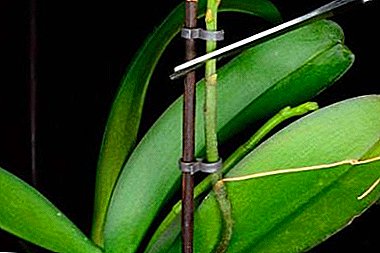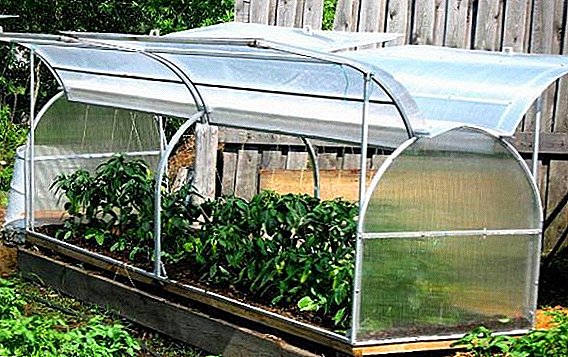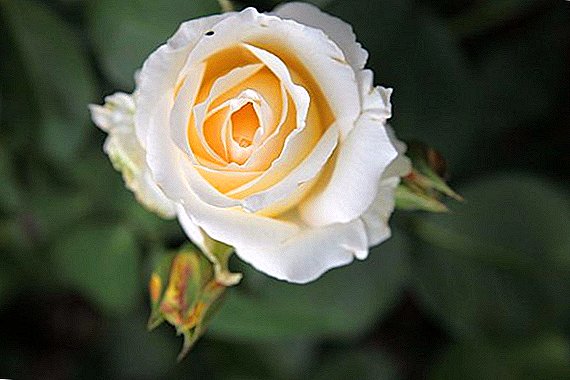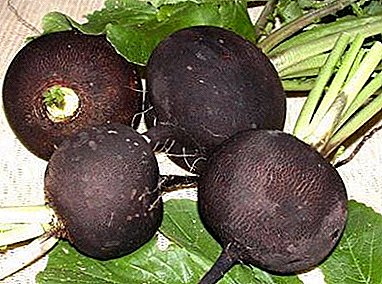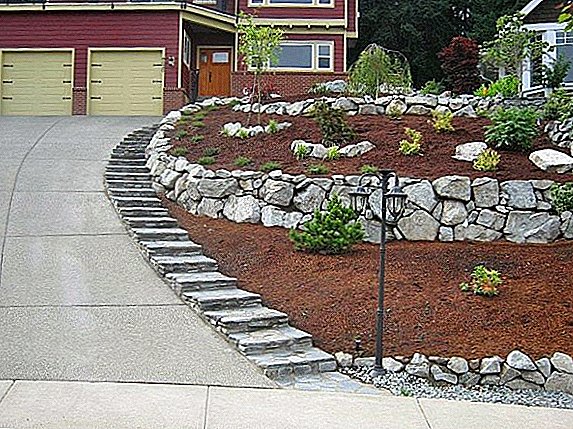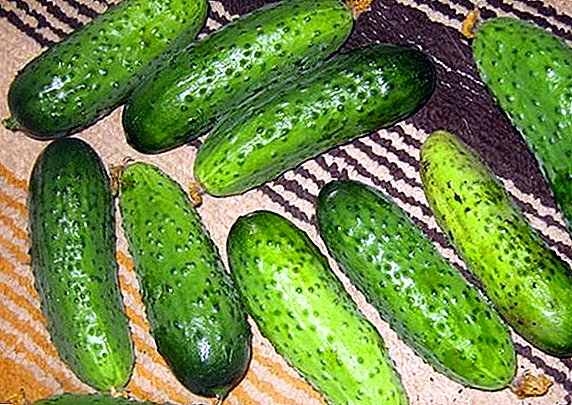 The finger boy is one of the early hybrids, which are often grown for pickling and harvesting for the winter. Easy to grow, resistant to disease, unpretentious to care, it becomes a noticeable addition to the garden of amateur gherkins. The variety has tasty small fruits and is characterized by good yields, especially if you adhere to the basic requirements of care. About them and other important details of the cultivation of cucumber, we will discuss further.
The finger boy is one of the early hybrids, which are often grown for pickling and harvesting for the winter. Easy to grow, resistant to disease, unpretentious to care, it becomes a noticeable addition to the garden of amateur gherkins. The variety has tasty small fruits and is characterized by good yields, especially if you adhere to the basic requirements of care. About them and other important details of the cultivation of cucumber, we will discuss further.
Variety description
This parthenocarpic hybrid was developed by Manul in 2000.
Parthenocarpic hybrids also include such varieties as "Hector f1", "Shosh f1", "Bouquet f1", "Cupid f1", "April f1", "Green stream f1", "Puff splendor f1".
A distinctive feature of the gherkin is a female type of flowering, prone to beam formation of ovaries. It is in demand practically throughout the territory of the CIS countries, as it is growing rapidly and producing abundant fruiting. 
Shrubs of medium size, vigorous, usually on each can be found from 2 to 6 bunches of the bouquet type. It is possible to grow plants in open areas and in greenhouse conditions. The recommended planting density is 2-3 plants per square meter of greenhouse, 3-4 shrubs in open ground conditions.
Important! Partenocarpic cucumber - such a hybrid that is able to produce fruits on a plant without the influence of an external pollinator. That is, these are varieties and hybrids that do not need pollinators to produce fruits (should not be confused with the process of selfing - in this case, the plant is pollinated by pistils and stamens growing on it, that is, it differs in both male and female type of flowering). Distinctive feature of parthenocarpic varieties - the practical absence of seeds in the fruit.
The little boy has such advantages:
- wonderful taste, fragrant flesh;
- good and attractive external indicators;
- large yields and undemanding care;
- fast ripening and long-term fruiting;
- good disease resistance;
- versatility in use - suitable for preservation and fresh consumption.

The hybrid has no disadvantages. It has an attractive appearance and high marketable quality, as it tolerates both long-term transportation and storage, and also has great fruiting indicators.
In addition, it very quickly adapts to new conditions, therefore it can grow in almost any territory.
Fruit characteristics and yield
Fruits ripen in about 40 days, reaching a length of up to 12 centimeters, tuberculate, oval in shape, without a neck. Externally, the fruit is attractive - green peel with poorly pronounced stripes and a slight fluffiness.
The flesh is very fragrant, without any mustard or void inside. Fruit weight ranges from 50 to 70 g. In the cucumbers are small seeds.
It is for the taste of this hybrid that received such recognition. Often fruits are used in the preparation of a variety of canned food and for the preparation of fresh salads.  Also cucumbers can be stored and transported for long distances.
Also cucumbers can be stored and transported for long distances.
Productivity - not less than 10 kilograms per square meter.
Important! If the cucumbers are not collected on time, they can outgrow because It is recommended to start collecting them upon reaching the gherkin size.
Selection of seedlings
To select high-quality cucumber seedlings, you need to know and follow these rules:
- height sprout must be at least 25 centimeters (for a period of 30 days after planting);
- the rudiments of the roots should be clearly visible - they look like white bumps;
- the presence of at least 5 leaves of average diameter (approximately 15 centimeters);
- seedlings should look healthy and strong, with a strong and durable stem, dark green leaves. If the seedlings are elongated and have a weak greenish color - the rules of cultivation have been violated, this is better not to choose;
- the roots for such a period already have time to braid the plots of land, should have a good and pleasant smell. If there is visible damage - do not choose such plants;
- seedlings can also be selected for planting (very small plants with one true leaf and two weeks old), but they should also look good and follow the rules described above. Such plants quickly take root in the ground and start growing in a short time.

Soil and fertilizer
For growing a hybrid, light and nutritious areas are best suited. "Fingers" prefer watertight and airtight soil. It is recommended to fertilize the land with peat and humus before planting seeds or seedlings.
Poorly tolerated acid earth. The area on which moisture is constantly stagnant does not fit, since it can harm both seedlings and already adult plants, causing rot and promoting the appearance of diseases.
Did you know? Columbus always took cucumbers with him on his travels. He ordered his sailors to eat them both in salted and fresh form in order to protect themselves from the scurvy that raged in those times.
The place for growth is chosen permanent. Planting is carried out at a time when the average soil temperature corresponds to +15 degrees. The hole should be no more than 3 centimeters deep, the distance between sprouts should be at least 20 centimeters. Disembarkation is carried out throughout May. 
It is better to prepare the beds in the fall. For optimal conditions, the soil is fertilized with manure (1 bucket per square meter), you can add mineral fertilizers, such as potassium, ash or superphosphate.
Such mineral fertilizers include Ammophos, Sudarushka, ammonium nitrate, Plantafol, Kemira, AgroMaster, nitroammophoska, Master.
Before planting, the ground is loosened, fertilized once more, and then seedlings are placed. The hybrid has no other requirements for landing.
Growing conditions
Loosening and removing weeds is an indispensable part of caring for plants. It is carried out after watering. In hot weather, plants should be watered twice a day - in the morning and in the evening, it is desirable that the water does not stagnate.
At first, only warm and settled water is used. If the days are rainy, watering is carried out as needed, the main thing is that the soil does not dry out.
It is also desirable to carry out and dressing with mineral and organic fertilizers (at least 6 times during the entire growing and fruiting season). 
In the first two weeks after planting or transplanting cucumbers can be given a little nitrogenous fertilizer.
But phosphate dressings are suitable during flowering. The optimum temperature is + 20-25 degrees. Also, plants need a sufficient amount of light for growth, but without direct sunlight.
Growing from seed to seedlings at home
Cucumbers can be grown in two ways - with the help of seedlings and directly into the ground. In order to get seedlings at home, you must adhere to several rules of planting and care. Features of planting seeds and transplanting seedlings - below.
Seed preparation
Seeds can be planted in both dry and germinated form. Before you use the seeds, they should be treated with a disinfecting solution. 
Usually, manufacturers carry out the treatment themselves, and the seeds do not need additional disinfection, but if you bought them in an untested place or for the first time, it is better to disinfect. Choose for planting the same size seeds. Sowing is carried out in warm soil, at least 15 degrees.
You can also plant prepared and germinated seeds. To do this, they are placed in wet gauze for a couple of days and left in a warm place. After the appearance of the first shoots they are transplanted into the ground.
Content and location
Clay tanks are great for planting. You can also choose special plastic containers or pots. The stagnation of water has a very harmful effect on the growth of seeds, because containers with special openings are better suited for the outflow of excess moisture. 
Place for planting should be with enough sunlight and be in a warm place. Capacity with seedlings is best placed on the windowsill. The soil should be nutritious and light.
You can buy ready-made in a specialized store or fertilize any of the available, adding a little mineral or natural fertilizers.
Seed planting process
It does not differ from the sowing of other varieties of cucumbers: the seeds are placed at a depth of about 1 centimeter, with their noses up at an angle of 45 degrees. For optimal germination at first, the ground is covered to create a greenhouse effect. After emergence of shoots it cleans up. 
Seedling care
Caring for a hybrid is quite simple, the main thing is to maintain the desired temperature, irrigate and monitor the amount of light.
- The optimum temperature at home is +25 ° C.
- It is necessary to ensure that the soil does not dry out, to conduct sufficient watering.
- Air humidity in the room is average.
- Shoots need a lot of daylight sunlight.
- It is necessary to loosen the earth from time to time, about once a week.
As soon as the cold ends, and a constant outside temperature is established, it is possible to harden the seedlings before planting. Hardening is carried out in the refrigerator, placing the seedlings there for a day or two. After that, it can be planted in open ground. 
Transplanting seedlings to ground
It is held in May, when frosts are already disappearing, and the soil warms up well (at least +15 ° C at a depth of 10 centimeters). Best suited last day of the month. Seedlings are planted on the 4th week after planting the seeds, when it is already able to withstand the influence of the external environment.
The distance between the shoots must be at least 30 centimeters. The depth of transplantation is 2 centimeters, no more than 4 plants are placed per square meter.
The sprout is removed from the pot with a clod of earth and placed in a well fertilized with manure, gently sprinkled with earth. After that, carry out watering. 
Agrotechnics growing seeds in open ground
The technique of planting seeds immediately in open ground is almost the same as the previous one. Differences are associated only with the maintenance and care, as well as the choice of location.
Did you know? In many eastern countries, cucumber is considered a dessert. It is served with fruit, sweets and tea. In some countries, it is even customary to cook cucumber jam.
Outdoor conditions
Sowing in the ground can be carried out both in greenhouse conditions and in open areas. If you grow cucumbers in the greenhouse - they will receive the necessary conditions for the growth of seeds, but will need abundant watering during flowering and harvest.
If, however, to plant seeds in open ground, the beds will need to be covered for several days, creating a greenhouse. To do this, fit a damp newspaper (should not dry out) or polyethylene. After the first shoots the greenhouse is removed. 
The place should warm up well, with enough sun and loamy nutrient land. Water in the soil should not stagnate.
The process of planting seeds in the ground
Sowing is carried out throughout May. Both dry and wet seeds can be used. The same and full-grown seeds are selected, the soil should be fertilized and slightly moist. Landing is carried out in the wells of a depth of 2-3 centimeters.
If a trellis is used, it is better to seed the seeds in a nested way. Nests are located at a distance of 20 centimeters from each other. Width between the beds - 40 centimeters. It is not recommended to plant plants in the ground, where cucumbers are constantly growing - it is better to choose another fertile site. 
Watering
Watering is carried out frequently and plentifully, at least twice a day in warm and hot weather (morning and evening). The first few weeks the water should be warm, you can defend it in large barrels. You can also use rainwater.
If drought sets in, the number of irrigations increases to 3 or 4 times per day. In rainy weather, watering is carried out as the soil dries. Be sure to ensure that the soil does not dry out. Also, watering increases during flowering and fruit picking.
Did you know? Cleopatra ate cucumbers every day. She believed that they allowed to preserve youth and beauty. Even today, they are included in many care products, masks and creams, as the cucumber allows you to maintain the freshness and beauty of the skin.
Soil loosening and weeding
From the beds it is necessary to remove all weeds. Weeding is carried out as they grow. Loosening is carried out after watering or rain, very carefully and shallowly, so as not to damage the root system. You can also carry out and mulching with the use of manure or peat. 
Masking
Serving allows you to increase the number of fruits in the future and stimulate the plant. It can be done in two ways.
- The first involves working with one main lash. It is suitable if cucumbers are planted close to each other. The main lash is tied up vertically or horizontally, which allows it to receive enough sunlight. This bed looks pretty neat, in addition, with this method of pinching the harvest is much easier to harvest.
- Second way - lateral processes are not removed, but pinched. This allows you to create a large lush bush. For this hybrid, the second method of pinching is recommended, which makes it possible to stimulate the growth of lateral shoots and to obtain greater yield. Pinching is carried out on the fourth or fifth true leaf of the plant.

Garter
Garter can be carried out in several ways. The most simple and effective - horizontal and vertical garters.
- Horizontal way requires placing along the edges of a bed of two long supports, between which a rope or a string is stretched in several layers. The stalks are already placed on it. The only negative is that if the stems are very large, they can hang and shade the plant.
- Vertical garter implies the presence of two high supports on opposite edges of the beds. Between them, at the very top, a solid wire or rope is pulled, on which ropes or fabric strips are tied up according to the number of bushes or stems. By hanging down the supports and tethered stems.
You can also use a special grid for cucumbers, which can be bought in the store. For this hybrid, any of the ways of garter is suitable, but the second shows the best results during fruiting. 
Top dressing
The first feeding is carried out during the preparation of the wells. Peat or humus is used for this. After sprouts reach three weeks of age, a small amount of mineral fertilizers is applied.
Further feeding is carried out in half with organic and mineral fertilizers up to 6 times during the whole season.
As an organic fertilizer, you can use straw, bone and fish meal, milk whey, potato peel, egg shells, banana skins, onion peel, nettle.
Bring them before watering the plants, loosening the soil in the hole and deepening fertilizer to a depth of 5-7 centimeters.
Pests, diseases and prevention
Plants are resistant to most diseases - powdery mildew, cucumber mosaic, olive blotch and others. But, like others, they are not insured against the appearance of sores or pests.
For prevention, it is necessary to conduct regular spraying with fungicides and soil disinfection. It is recommended to plant disinfected seeds. 
Also, the prevention of the appearance of any disease includes the timely weeding and loosening, proper fertilization and compliance with irrigation and temperature regimes. If the soil is too cold during planting, the plant grows weak.
In the case when moisture stagnates, it can lead to rotting of the roots or shoots.
Important! Remember the rules of crop rotation. Do not plant cucumbers in the same places. This will entail a number of serious diseases of young plants, low yields, poor growth and other troubles.
Harvesting and storage
Harvesting should be carried out at least three times a week, preferably every two or three days. The more often you remove the fruit, the more fruit the bush. Fruits are carefully separated to preserve the stem. 
Cucumbers are removed when they reach the size of 7 centimeters, but not more than 11. It is better to choose for this morning or evening hours.
Cucumbers can withstand long movements, but for this to be low temperature. Stored in dark and cool places. After collecting it can be placed in the shade, while washing is not recommended.
Fresh stored not very long, so they are best eaten immediately or allowed for pickling. And in one, and in another form have excellent taste.
Possible problems and recommendations
Problems with a hybrid appear quite rarely, as it is quite resistant to diseases. If the leaves turn yellow, fall off, the plant rot, the problem may be poor ventilation or excessive watering. In the case when the leaves turn yellow and dry - the problem is insufficient irrigation. 
Sometimes fruits can fall off - this is the result of too rare a harvest.
The main mistakes that can make a gardener:
- planting cucumbers in the same place;
- planting adult seedlings;
- improper formation of bushes.
In this case, the plants do not grow well, they are characterized by a weak leaf color, lethargy. Be sure to follow the planting schemes, fertilizer and irrigation, then problems can be avoided in most cases.
Cucumbers of this variety are distinguished by their particular unpretentiousness to the conditions and high resistance to diseases. And they have excellent taste and attractiveness. These strengths made them a useful addition to any vegetable garden or household.
And to obtain the maximum amount of tasty fruits, healthy bushes, follow the basic recommendations of sowing and planting. Then you can enjoy not only fresh cucumbers in the summer, but also wonderful salty gherkins in the winter.


